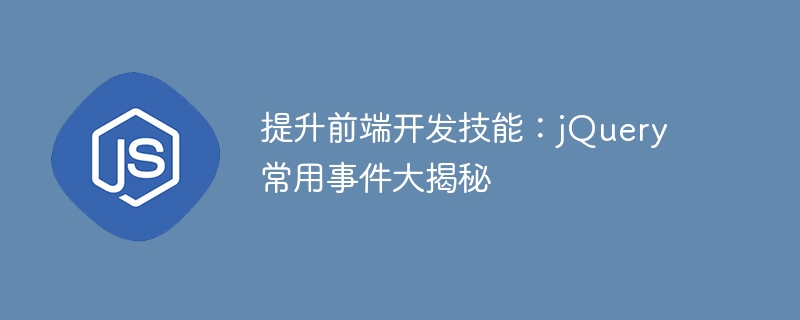

In the field of front-end development, jQuery is a very popular JavaScript library that simplifies tasks such as DOM manipulation, event handling, animation effects, etc. Among them, event processing is a very important part of front-end development. Mastering common event processing methods can help developers implement more interactive and functional web applications. In this article, we will delve into common jQuery events and demonstrate their use through specific code examples to help readers better understand and master these technologies.
In jQuery, you can use the on() method to bind event handlers. This way you can add one or more event handlers for one or more selected elements. The following is a simple example that demonstrates how to add a click event handler for a button:
<!DOCTYPE html>
<html>
<head>
<script src="https://code.jquery.com/jquery-3.6.0.min.js"></script>
</head>
<body>
<button id="myButton">Click me</button>
<script>
$("#myButton").on("click", function() {
alert("Button clicked!");
});
</script>
</body>
</html>In this example, when the user clicks the button, a prompt box will pop up showing "Button clicked!".
jQuery supports many different types of events, including click events, mouse events, keyboard events, form events, etc. The following lists some commonly used event types and their corresponding sample codes:
Click event: Triggered when the element is clicked.
$("#myButton").on("click", function() {
// 点击事件处理程序
});Mouse events: Including mouse move in, move out, hover and other events.
$("#myElement").on({
mouseenter: function() {
// 鼠标移入事件处理程序
},
mouseleave: function() {
// 鼠标移出事件处理程序
}
});Keyboard events: Triggered when a keyboard key is pressed or released.
$(document).on("keydown", function(event) {
console.log("Key pressed: " + event.key);
});Form events: Including events such as submitting the form and changing the content of the form.
$("#myForm").on("submit", function(event) {
event.preventDefault(); // 阻止表单提交
// 表单提交事件处理程序
});Event delegation is a method of optimizing the performance of event handlers by binding events to ancestor elements rather than directly to descendant elements , which can save a lot of resource overhead. The following is a sample code for event delegation:
<!DOCTYPE html>
<html>
<head>
<script src="https://code.jquery.com/jquery-3.6.0.min.js"></script>
</head>
<body>
<ul id="myList">
<li>Item 1</li>
<li>Item 2</li>
<li>Item 3</li>
</ul>
<script>
$("#myList").on("click", "li", function() {
alert($(this).text() + " clicked!");
});
</script>
</body>
</html>In this example, when the user clicks on any li element in the list, a prompt box will pop up to display the text content of the element. .
In addition to the natively supported event types, jQuery also allows developers to create custom events and trigger these events. The following is a sample code for a custom event:
$("#myElement").on("customEvent", function() {
console.log("Custom event triggered!");
});
$("#myElement").trigger("customEvent");In this example, when the code is executed to trigger the custom event, "Custom event triggered!" will be output on the console.
Sometimes you need to remove a bound event handler. You can use the off() method to complete this operation. Here is a sample code to remove an event handler:
function clickHandler() {
alert("Element clicked!");
}
$("#myElement").on("click", clickHandler);
$("#removeButton").on("click", function() {
$("#myElement").off("click", clickHandler);
});In this example, when the "removeButton" button is clicked, the click event handler on the "myElement" element is removed.
By learning and mastering jQuery’s common event handling methods, developers can process and respond to user operations more flexibly, improving the interactive experience of web applications. We hope that the code examples and explanations provided in this article can help readers better understand and apply these technologies and improve their front-end development skills.
The above is the detailed content of Improve front-end development skills: Revealing the secrets of jQuery common events. For more information, please follow other related articles on the PHP Chinese website!